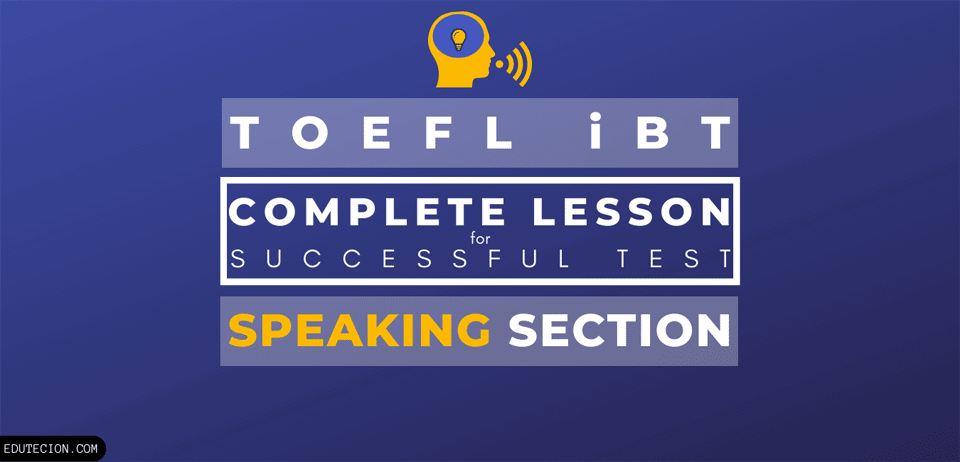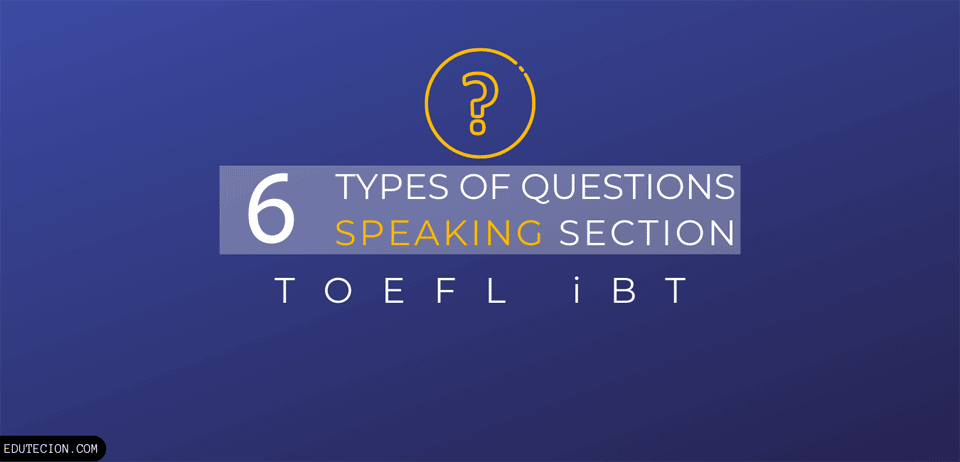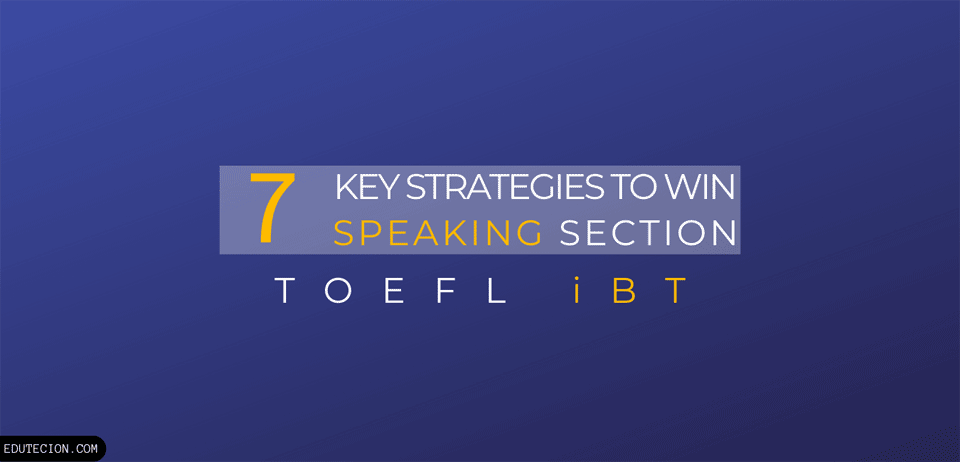7 Most Effective Strategies for Speaking Section of TOEFL iBT (UPDATED 2024)
Are you struggle to find the most effective strategies for speaking section of toefl ibt? Here, you can learn about them to score well for free.

Most Effective Strategies for Speaking Section of TOEFL iBT – In TOEFL iBT, speaking is the third section that you must perform to complete the test. It examines your English speaking proficiency by asking questions that invite you to respond.
According to CSCanada, speaking is the most difficult skill to master by college students where English as their foreign language.
Don’t worry if you have a similar problem. Here, you can improve your speaking proficiency and perform well in the speaking section of TOEFL iBT.
That’s why I make these lessons so you can prepare well for the test and improve your speaking proficiency overall. So, are you interested?
Keep in mind, an investment in knowledge pays the best interest.
So, Are you ready? Let’s go and get them!
Table of Contents 📚
Formats in the Speaking Section of TOEFL iBT
In TOEFL iBT, you will face two distinctive formats that required different responses. So, learning all formats helps you practice efficiently.
In the official test, you require to reply to Independent Speaking Tasks and Integrated Speaking Tasks. Yes, these are the format of the speaking section.
You can learn each format below. Let’s dig in!
Independent Speaking
As you begin the speaking section, you will receive two instructions or questions. These instructions ask you to respond using your ideas, opinions, and experiences.
Integrated Speaking
Integrated Speaking has four instructions or questions. You need to respond to the questions based on the given listening passage or both listening and reading passage.
See, you need to respond to six instructions or questions in total. Also, the topics for this speaking section include personal experience, campus-based situations, and academic-type content material.
Did you know?
They named the second format as Integrated Speaking because it challenges you to integrate your English language skills. So, you need to be able to combine your listening and speaking as well as listening, reading, and speaking skills at the same time.
After you reach this point, I know you can differentiate each format after reading those. Yeah, you did a great job!
You can know more about how much time you need in giving a response to each question below.
How Long Speaking Section in TOEFL iBT Takes
Hey, don’t forget this:
The speaking section takes about 20 minutes to complete. You have 45 to 60 seconds to respond to each instruction or question. So, time your speech accordingly during practice. It helps a lot during the real test!
Great.
As you know, Integrated Speaking provides you with the listening passage or both listening and reading passage. So, for the instructions with the listening passages, you will listen to short spoken passages or conversations on your headset.
For the ones with the reading passages, you will see short written passages on the screen.
Did you know?
You can utilize the provided papers and pen to assist you during the speaking section.
See, you can note down the points of your responses for each instruction.
What a relief, right?
Alright, it’s great that you reach this point. Knowing how much time you have to respond to each instruction is beneficial.
It’s even better when you know how to answer all questions in the speaking section of TOEFL iBT correctly.
You may ask how?
The answers show below. So, are you ready to dig in even more? Yes, let’s jump in!
How to Answer Questions in the Speaking Section of TOEFL iBT
You respond to each instruction or question by speaking into a microphone. Make sure that your pronunciation and fluency of speech are clear and crisp.
To make it clear, I describe the specific ways to answer each instruction or question practically. So, I divide the ways based on its format – Independent and Integrated Speaking.
For Independent Speaking, there is clear information about when to begin to prepare your response and when to begin speaking.
- After you read the question, a timer for preparation will appear below the question and start to count down from 15 seconds.
- Every time the timer ends, you will hear a cue like a short beep.
- After that cue, you need to speak into the microphone to respond to the instruction or question.
- Remember, you have 45 seconds to deliver all your responses toward the instruction or question.
- The timer will stop as a new screen appearing whether you speak or not.
For Integrated, there is also clear and a bit longer information about the instruction and question.
- You will listen to the instruction and see a reading material.
- Then you will listen to one or two speakers discussing and delivering opinion about the topic from the reading material.
- After that, you will see a question on the screen asking about what you’ve read and heard.
- Remember, you have 30 seconds to gather your thought before the cue or short beep resonances.
- After you heard the short beep, you have 60 seconds to address your response.
- The timer will also stop as a new screen appearing whether you speak or not.
Here the tips:
You can take notes when the instruction begins, reading material appears, and speakers talk. Also, use your 30 seconds before the cue to arrange the points that you will deliver after you know the question.
Remember:
You can begin to speak right after the short beep resonances. Also, speak fluently and clearly.
Well done, you’ve reached this point, meaning you’ve learned how to answer questions in the speaking section of TOEFL iBT practically.
Now, you can learn the most popular part of this lesson. It’s the types of questions in the speaking section of TOEFL iBT.
Are you ready? Let’s begin!
Types of Questions in the Speaking Section of TOEFL iBT

You can practice your speaking proficiency effectively for the test if you know the types of questions that TOEFL iBT asks you.
Also, you will sooner or later notice that the benefits of your practice now help you more. Yes, your practice for the TOEFL iBT will improve your speaking proficiency overall, not only for the test but also for real life.
Think about the snowball effect that gives you benefit resulting in other benefits.
It sounds great, right?
Well, without further ado. Let’s get started!
Independent Speaking Tasks
You will meet two types of questions in Independent Speaking. Well, check them out below.
1. Describing and Giving Reasons
Describing and giving reasons is the first type of question in the speaking section of TOEFL iBT. As an Independent Speaking question, you can explain anything based on the information that you have.
Keep in mind:
This type of question asks you to describe a great experience, a favored activity, or an important character. Also, it requires you to give reasons for why that experience was great, why that activity was favored, or why that character was important.
Simply, the question will ask you to mention one particular thing and why it matters for you.
Hot tip:
Avoid proffering long lists when presenting descriptions. Instead, list a few descriptions but meaningful. You only have 45 seconds, so make it counts.
2. Stating Opinion and Providing Supportive Reasons
Stating preference or opinion to support your choice and providing supportive reasons and details is the second type of question in this speaking section.
Keep in mind:
This type of question demands you to choose one between two possible actions, situations, or opinions. Then, you have to provide supporting reasons and details to back up your choice.
For instance:
The question will ask you which learning is more effective, conventional learning or e-learning.
or,
Whether or not student loan has been a benefit for the student.
Hot tip:
Practice more in using expression to deliver opinions, such as in my opinion, I believe, in my opinion, from my perspective, and more.
Also, practice more on stating one opinion or choice and presenting reasons clearly with detail in 45 seconds.
Integrated Speaking Tasks
In addition to two types of questions above, you will encounter four more types of questions in Integrated Speaking.
3. Identifying and Summarizing Speakers’ Point of View
This type of question examines your capacity to integrate information from two sources – reading and listening passage.
Unlike Independent Speaking Tasks, this type of question doesn’t ask your opinion. Instead, you need to identify the point of view or opinion of the speaker and summarize why that speaker has that particular belief.
Keep in mind:
It’s crucial to understand what the question asks you to do and what you don’t do. So, taking notes while reading and listening to the passage is helpful.
Hot tip:
Pay close attention to the intonation, stress, and word choice of the speaker to recognize his or her point of view or opinion. If needed, take it on the notes for your reference in delivering a response for 60 seconds.
4. Distinguishing Major Points and Detailed Information
Here, you will also read and listen to a short passage about any academic subject and a brief explanation of the professor for that subject.
Keep in mind:
It’s important to comprehend general information provided in the reading passage and specific information by the professor.
Hot tip:
Use the provided papers and pen to note the major points and detailed information from the reading and listening passage.
Also, practice more on making outlines from major points in the reading passage and obtaining specific information from the listening passage.
In delivering the response, use those outlines to summarize the information and utilize the details as supporting data to support that conclusion.
Make it clear and precise because you only have 60 seconds to deliver all of them.
5. Showing Understanding and Building Engagement
Now, this type of question is a bit different. Here, you will not see any reading passage anymore. Instead, you will only listen to a short conversation.
Keep in mind:
This type of question challenges you to show your understanding of what you’ve just heard. Also, it examines the level of engagement you build based on what you’ve heard.
For instance:
You’ve listened to a conversation with two people. Where they discussed a problem that one of them has and two possible solutions for that problem.
The question will ask you to mention the problem and which solution you support to solve the mentioned problem.
Hot tip:
Sharpen your understanding toward a discussion or conversation about a particular topic or problem and relate yourself to the situation by choosing the best solution or opinion for the problem.
Also, in answering the question, imagine you’re retelling someone’s problem and stating the best solutions for that in 60 seconds.
6. Utilizing and Summarizing Information
Last but not least, this type of question provides a single speaker that talks about any academic subject. So, you will hear a form of a monolog.
For instance:
A professor describes a brief explanation about an academic subject as a part of a lecture in the classroom. And, the question will ask you to reexplain what you’ve heard from the monolog.
Hot tip:
Utilize your note-taking to list worth-sharing information form the listening passage. So, you can bring an accurate response to the question in 60 seconds.
See, knowing all types of questions gives you a clear insight about what to do as you begin speaking section after 10 minutes break from the reading section.
Now, at this point, you’re very close to winning the speaking section in TOEFL iBT.
Complete your preparation and extend your understanding by recognizing key strategies to win this section below. As you know, knowing types of questions alone is not enough to win TOEFL iBT. So, let’s get started to learn more about the cheat-sheet below.
Key Strategies to Win Speaking Section of TOEFL iBT

In seconds, you’ll know the key strategies to win the speaking section of TOEFL iBT. Remember, these strategies will work if you practice them regularly. Now, let’s jump in!
1. Speak Confidently
The success of your speaking will be judged by the knowledge you send and by what the raters receive. So, speak confidently to make your listeners or the raters get your responses to all questions.
Keep in mind:
Avoid speaking or delivering responses in a very low voice, hesitation, and apologizing. If you do so, the raters assume that you’re not confident or you don’t know the answer. It will end badly for your score.
So, speak up and enunciate confident without being aggressive.
2. Love Your Accent
Wherever you’re from, your mother tongue language has a big impact on influencing you to use English. Conscious or unconsciously, the manner of your pronunciation in English characterized by your region, ethnic, or first language.
So, that’s okay because diversity is unity.
Beat you worry or negative presumption about your accent or pronunciation that isn’t like a native speaker. Be yourself and be confident.
Remember, the most important in the speaking section of the TOEFL iBT test is how to make the raters understand your responses.
So, the raters won’t rate your accent anyway. They rate your speaking proficiency in understanding and using English, that’s it.
See, be proud of yourself. Your accent defines who you are. It’s your unique element. Cheers!
3. Optimize Your Verbal Pauses
Did you know? You will lose the point when you say nothing or silence during the given respond-time.
So, the only way for you to cover the point when you don’t know what to say is to use verbal pauses. Verbal pauses back you up when you’re thinking about what to say.
Have you ever think in silence when your friend asked something you don’t know? Then, he or she asked you again or poked you to confirm you listened or understood the question. You understood the question except you’re just thinking.
During the speaking section, you will hear the question once and the computer won’t poke you to confirm your understanding of the question when you’re in silence.
So, use um, uh, and, okay, now necessarily – don’t use it too often. These are verbal pauses that acceptable by the raters because they use by native speakers commonly in the speech.
They’re the bridges that help you to cross the abyss of no-idea-to-say.
See, this strategy is simple and positively impactful.
4. Kick the Mistakes Out
Even native speakers made mistakes and slips during the speaking. As you know, nobody is perfect. But, during respond-time in the speaking section of TOEFL iBT, perfection is necessary.
So, what should I do when I made a mistake or slip? The answer is to kick that mistake and slip out.
Then, you might ask how?
You can kick the mistake and slip out by using these magic phrases – I mean or that is.
So, whenever you made mistakes and slips in grammar and word choices, use those phrases.
They help you to indicate the raters that you realized your mistake and going to provide revision. It’s effective if you can do it instantly and move along without interrupting the flow of your response delivery process.
5. Maximize Your Reading Speed
Remember, in the speaking section, you will see reading passages and hear listening passages. And, you only have 45 seconds to read the 75 – 100 words passage.
So, maximize your reading speed is also a key strategy in the speaking section.
How to increase your reading speed?
The answer is to practice reading 150 words per minute.
Also, you can practice more key reading strategies HERE.
6. Be Familiar with The Questions
To give an accurate response to each question, you have to understand that question. So, you must read again and keep in your memory the types of questions that I provided above.
That’s the only efficient way.
7. Boost Your Note-Taking Ability
Especially for Integrated Speaking, you will encounter reading and listening passages. So, to manage all the information that you’ll use to respond to the questions, you need to note down all major points.
And, you also need to note down the list of points that you’ll speak up as a response to the question.
The only efficient and allowed way is note-taking.
As you know, everyone can do that. However, only those who know the special ways can do it efficiently or better.
Conclusion
In TOEFL iBT, you’ll encounter the speaking section after reading and listening section. This section aims to test your speaking proficiency using English. During the test, you need to respond to each question verbally to the microphone. Knowing the basics of the speaking section, formats, types of questions and strategies to accurately reply to those questions is a lifesaver.
Remember, you can practice and prepare well for the test using this lesson.
I know you can do it!
Congratulation! you have completed this lesson. I hope you find it helpful. If you have any questions regarding this lesson, feel free to mention it in the comment. Also, you can share the effective strategies that you used to win the speaking section in TOELF iBT previously, so others can learn more. Cheers!